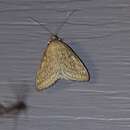Conservation Status
provided by University of Alberta Museums
Common, of no concern
- license
- cc-by-nc
- copyright
- University of Alberta Museums
Cyclicity
provided by University of Alberta Museums
Mid May to mid July.
- license
- cc-by-nc
- copyright
- University of Alberta Museums
Distribution
provided by University of Alberta Museums
Nova Scotia to southern British Columbia, south to New Jersey, Arizona and northern California (Munroe 1976). Reported from Areas 7 (Lloydminster), 10 (Edmonton), 18 (Hillcrest and Blairmore) and 20 (Nordegg) in Alberta by Bowman (1951) as Loxostege chortalis Grt. The Area 20 report, however, was based on a misdetermined specimen of Saucrobotys futilalis inconcinnalis. Also known in Alberta from Blairmore, Buffalo Lake Conservation Area, Burbank, Dry Island Buffalo Jump Provincial Park, Erskine, Hillcrest, Lowden Springs Conservation Area, Nevis, Pine Lake, Rochon Sands Provincial Park and Tolman Bridge.
- license
- cc-by-nc
- copyright
- University of Alberta Museums
General Description
provided by University of Alberta Museums
Wingspan around 27 mm. Ground color of fore and hind wings whitish-buff with greenish-gray transverse, dentate or crenulate lines. Easily recognized.
- license
- cc-by-nc
- copyright
- University of Alberta Museums
Habitat
provided by University of Alberta Museums
Grassland and prairie areas
- license
- cc-by-nc
- copyright
- University of Alberta Museums
Life Cycle
provided by University of Alberta Museums
Described by Munroe (1976). Moths nocturnal but easily flushed (Munroe 1976).
- license
- cc-by-nc
- copyright
- University of Alberta Museums
Trophic Strategy
provided by University of Alberta Museums
Larvae on pigweed (Amaranthus retroflexus) and probably other plants (Munroe 1976).
- license
- cc-by-nc
- copyright
- University of Alberta Museums
Sitochroa chortalis: Brief Summary
provided by wikipedia EN
Sitochroa chortalis, the dimorphic sitochroa moth, is a moth in the family Crambidae. It was described by Augustus Radcliffe Grote in 1873. It is found in North America, where it has been recorded from Nova Scotia to southern British Columbia, south to New Jersey, Arizona and northern California. The habitat consists of grassland and prairie areas.
Adults are on wing from mid-May to mid-July.
The larvae feed on Amaranthus retroflexus.
- license
- cc-by-sa-3.0
- copyright
- Wikipedia authors and editors

